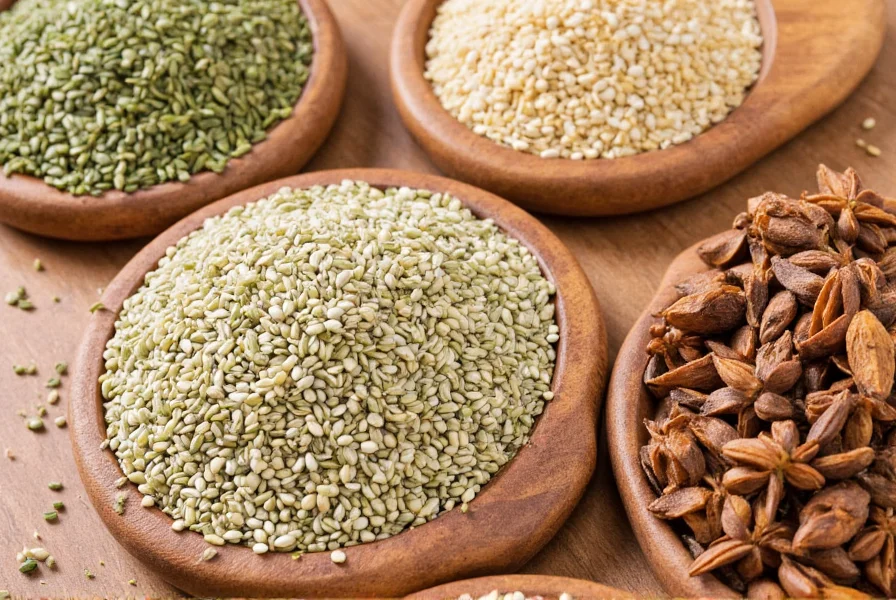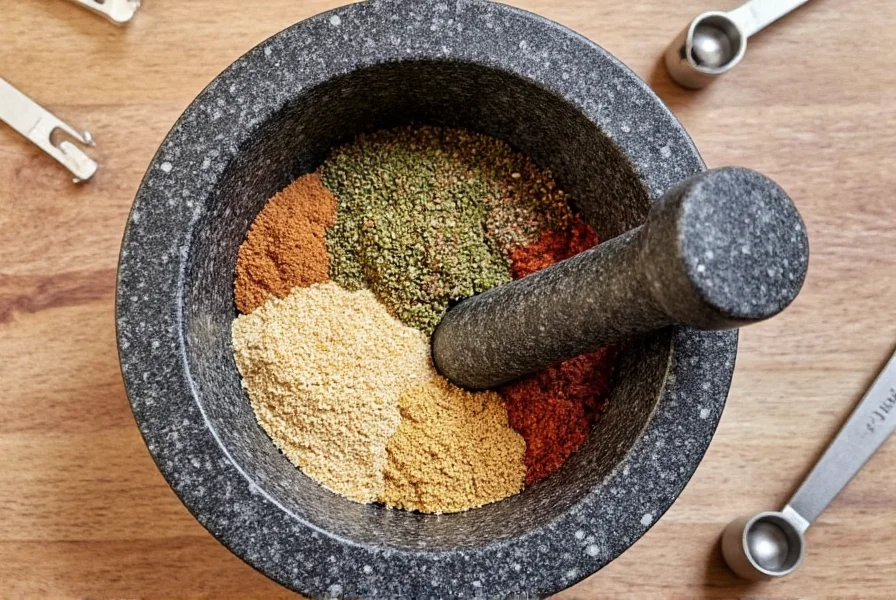When you're in the middle of preparing traditional European dishes like rye bread, sauerkraut, or goulash and realize you're out of caraway seeds, knowing reliable substitutes becomes essential. Caraway seeds provide a distinctive earthy, slightly sweet flavor with subtle anise notes that's difficult to replicate exactly, but several pantry staples can effectively stand in depending on your specific recipe and flavor preferences.
Understanding Caraway Seeds and Their Unique Flavor
Caraway seeds come from the Carum carvi plant, a member of the parsley family. Despite their name, they're actually the dried fruit of this biennial plant. Their flavor profile combines earthy, citrusy, and slightly peppery notes with a distinctive anise-like sweetness that becomes more pronounced when toasted. This complex flavor makes them indispensable in Central and Eastern European cuisine, particularly in rye breads, potato dishes, sauerkraut, and certain cheeses.
Top 6 Caraway Seed Substitutes with Usage Guidelines
Not all substitutes work equally well across all recipes. The best alternative depends on what dish you're preparing and which aspect of caraway's flavor you're trying to replicate.
1. Dill Seeds
Dill seeds offer the closest flavor match to caraway seeds, sharing similar earthy and slightly citrusy notes. While dill has a more pronounced herbal quality, it lacks caraway's intense anise flavor. This makes it an excellent 1:1 substitute in breads, potato dishes, and vegetable preparations.
Best for: Rye bread, potato salads, roasted root vegetables
Ratio: Use equal amounts (1:1 substitution)
Tip: Toast dill seeds lightly before use to enhance their earthy notes
2. Fennel Seeds
Fennel seeds provide the strongest anise flavor of all substitutes, making them ideal when you specifically need that licorice-like quality. They're slightly sweeter and less earthy than caraway, so use slightly less than the recipe calls for.
Best for: Sauerkraut, braised meats, certain sausages
Ratio: Use 3/4 the amount of caraway called for
Tip: Combine with a pinch of cumin to better replicate caraway's earthiness
3. Anise Seeds
Anise seeds deliver a more intense licorice flavor than caraway, making them suitable when that specific note is essential to your dish. They lack caraway's earthy complexity, so they work best in sweet applications rather than savory dishes.
Best for: Sweet breads, certain cookies, fruit compotes
Ratio: Use half the amount (1/2 substitution)
Tip: Anise works particularly well in recipes where caraway is used primarily for digestive benefits
4. Cumin
While cumin lacks the anise notes, it provides the earthy, warm quality of caraway with a more pronounced peppery finish. This makes it a good option when you need that grounding earthiness rather than the licorice flavor.
Best for: Goulash, stews, meat dishes
Ratio: Use half the amount of caraway called for
Tip: Add a tiny pinch of star anise to better approximate caraway's complete flavor profile
5. Carrot Seeds
Often overlooked, carrot seeds have a surprisingly similar flavor profile to caraway since both plants are in the Apiaceae family. They offer a milder version of caraway's earthy-anise combination.
Best for: Vegetable dishes, soups, certain breads
Ratio: Use equal amounts (1:1 substitution)
Tip: Best used when you have access to fresh carrot seeds rather than store-bought
6. Juniper Berries
Juniper berries provide a piney, slightly citrusy flavor that can work in certain savory applications where caraway is used for its earthy notes rather than its anise quality. They're particularly effective in meat dishes.
Best for: Game meats, certain sauerkraut variations, hearty stews
Ratio: Use 1/3 the amount of caraway called for
Tip: Crush juniper berries before using to release their oils and mellow their sharp flavor
| Substitute | Flavor Comparison | Best Ratio | Ideal Dishes | Limitations |
|---|---|---|---|---|
| Dill Seeds | Closest match, more herbal | 1:1 | Rye bread, potato salads | Lacks strong anise notes |
| Fennel Seeds | Stronger anise, sweeter | 3/4 amount | Sauerkraut, braised meats | Too sweet for some applications |
| Anise Seeds | Intense licorice, less earthy | 1/2 amount | Sweet breads, fruit dishes | Overpowers savory dishes |
| Cumin | Earthy, peppery, no anise | 1/2 amount | Goulash, meat dishes | Lacks signature anise note |
| Carrot Seeds | Milder caraway flavor | 1:1 | Vegetable dishes, soups | Less commonly available |
| Juniper Berries | Piney, citrusy alternative | 1/3 amount | Game meats, hearty stews | Distinctly different profile |
Special Considerations for Specific Dishes
Certain recipes have particular requirements when substituting caraway seeds:
Rye Bread and Other Baked Goods
For traditional rye bread recipes, dill seeds provide the most authentic substitute. If you're making Scandinavian rye bread (rugbrød), consider using a combination of fennel seeds and a tiny pinch of anise to better replicate caraway's complex flavor. In sweet applications like certain German cookies, anise seeds work better than savory substitutes.
Sauerkraut and Fermented Vegetables
When making sauerkraut or other fermented vegetables that traditionally use caraway, fennel seeds are your best option. They provide similar digestive benefits while complementing the tangy flavor of fermented cabbage. Use slightly less than the recipe calls for to prevent overwhelming the dish.
Goulash and Hearty Stews
For Hungarian goulash and similar meat stews, cumin provides the earthy foundation that caraway would normally contribute. Add a single crushed juniper berry per serving to introduce a subtle complexity that approximates caraway's distinctive profile without the pronounced anise flavor.
When Substitution Isn't Recommended
While substitutes work well in most cases, some traditional recipes rely so heavily on caraway's unique flavor that substitution significantly alters the dish. Authentic Czech kolache pastries, certain German schmierkase (cheese spreads), and traditional Austrian strudel varieties are best made with actual caraway seeds when possible. In these cases, consider making a special trip to a specialty grocery store or ordering online rather than substituting.
Storing and Maximizing Flavor of Substitutes
To get the most flavor from your caraway seed substitutes, store them properly and prepare them correctly:
- Keep seeds in airtight containers away from light and heat
- Toast seeds lightly in a dry pan before use to enhance their natural oils
- Grind seeds just before use for maximum flavor impact
- Use fresh substitutes (seeds lose potency after 6-12 months)

Creating Your Own Caraway Seed Blend
For recipes where caraway is a key ingredient, consider creating a custom blend that better approximates its complex flavor profile:
- For savory dishes: Combine 2 parts dill seeds + 1 part fennel seeds + a pinch of cumin
- For sweet applications: Combine 2 parts fennel seeds + 1 part anise seeds + a pinch of coriander
- For breads: Mix equal parts dill seeds and fennel seeds
This approach gives you more control over the final flavor than using a single substitute and works particularly well for recipes where caraway seeds are a featured ingredient rather than just a background note.

Final Thoughts on Caraway Seed Substitutes
While no single substitute perfectly replicates caraway seeds' unique flavor profile, understanding the characteristics of available alternatives allows you to make informed choices based on your specific recipe and flavor goals. The key is identifying which aspect of caraway's flavor is most important for your dish—whether it's the earthy foundation, the subtle anise notes, or the digestive properties—and selecting a substitute that best provides that element. With these guidelines, you can confidently continue your cooking even when caraway seeds aren't available in your pantry.
What is the best caraway seed substitute for rye bread?
Dill seeds are the best 1:1 substitute for caraway seeds in rye bread. They provide a similar earthy flavor with subtle herbal notes that complement the dense texture of rye. For a more complex flavor that better approximates caraway, use a blend of equal parts dill seeds and fennel seeds.
Can I use cumin instead of caraway seeds in sauerkraut?
While cumin can work in sauerkraut, it's not the ideal substitute as it lacks the anise notes that complement fermented cabbage. Fennel seeds are a better option, using about 3/4 the amount of caraway called for in the recipe. If using cumin, add a tiny pinch of anise or star anise to better replicate caraway's distinctive flavor profile.
How much fennel seed should I use to replace caraway seeds?
Use 3/4 the amount of fennel seeds compared to what the recipe calls for in caraway seeds. For example, if a recipe requires 1 teaspoon of caraway seeds, use 3/4 teaspoon of fennel seeds. Fennel has a stronger anise flavor than caraway, so using slightly less prevents it from overwhelming the dish.
Are caraway seeds and anise seeds the same thing?
No, caraway seeds and anise seeds are not the same, though they share similar anise-like flavor compounds. Caraway seeds come from the Carum carvi plant and have a more complex flavor with earthy, citrusy notes alongside the anise. Anise seeds come from Pimpinella anisum and have a stronger, sweeter licorice flavor with less earthiness. They can substitute for each other in some recipes but aren't interchangeable 1:1.
Can I use caraway seed substitutes for digestive benefits?
Yes, several caraway substitutes offer similar digestive benefits. Fennel seeds and anise seeds both have carminative properties that help reduce bloating and gas, similar to caraway. Dill seeds also provide mild digestive benefits. For maximum effect, use these substitutes in tea form or in dishes specifically prepared for digestive support, using the same ratios as you would for flavor substitution.










 浙公网安备
33010002000092号
浙公网安备
33010002000092号 浙B2-20120091-4
浙B2-20120091-4